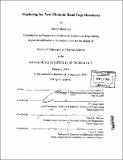Exploring for new photonic band gap structures
Author(s)
Maldovan, Martin
DownloadFull printable version (3.687Mb)
Other Contributors
Massachusetts Institute of Technology. Dept. of Materials Science and Engineering.
Advisor
W. Craig Carter and Edwin L. Thomas.
Terms of use
Metadata
Show full item recordAbstract
In the infinite set of possible photonic band gap structures there are no simple rules to serve as a guide in the search for optimal designs. The existence and characteristics of photonic band gaps depend on such factors as dielectric contrast, volume fraction, symmetry and connectivity of the dielectric structure. In this thesis a large set of photonic structures are developed to help understand the nature of the dependencies and provide a platform for easy fabrication of three-dimensional structures with large complete photonic band gaps. Two approaches for accessing new structures are examined. A systematic method based on crystallography to search for photonic band gap structures is established in this thesis. A search within the FCC space groups is undertaken resulting in the discovery of two new photonic band gap structures. Specific structures found in self-organizing systems, the single P, the single G, and single D structures, are shown to possess large photonic band gaps. Design guidelines to fabricate these structures by interference lithography are given. A layer-by-layer approximation of the single D structure amenable to fabrication by conventional semiconductor fabrication techniques is proposed. A second technique for obtaining photonic band gap structures with different topologies is based on the splitting of nodes in the diamond network. The realization of these structures using block copolymer self assembly and layer-by-layer lithographic technique are briefly examined.
Description
Thesis (Ph. D.)--Massachusetts Institute of Technology, Dept. of Materials Science and Engineering, 2004. Includes bibliographical references (leaves 103-104).
Date issued
2004Department
Massachusetts Institute of Technology. Department of Materials Science and EngineeringPublisher
Massachusetts Institute of Technology
Keywords
Materials Science and Engineering.